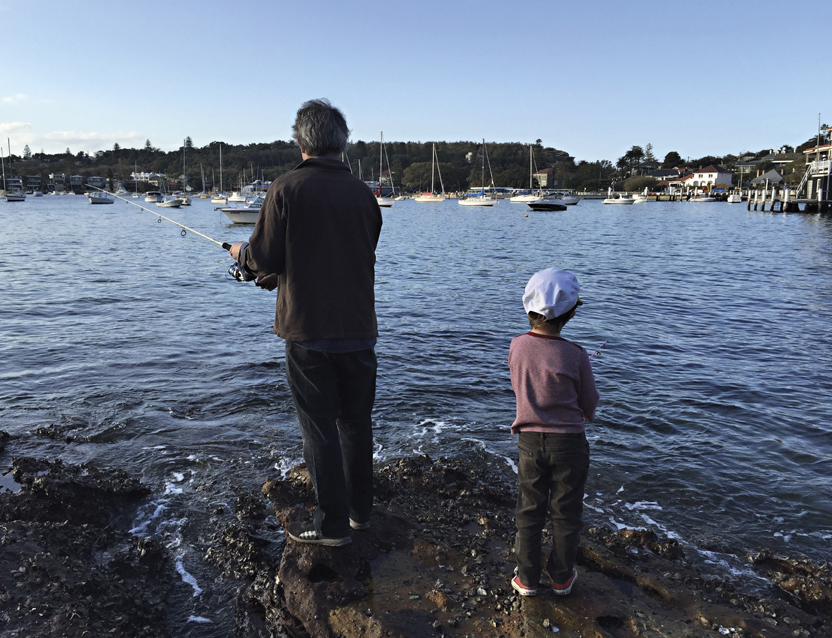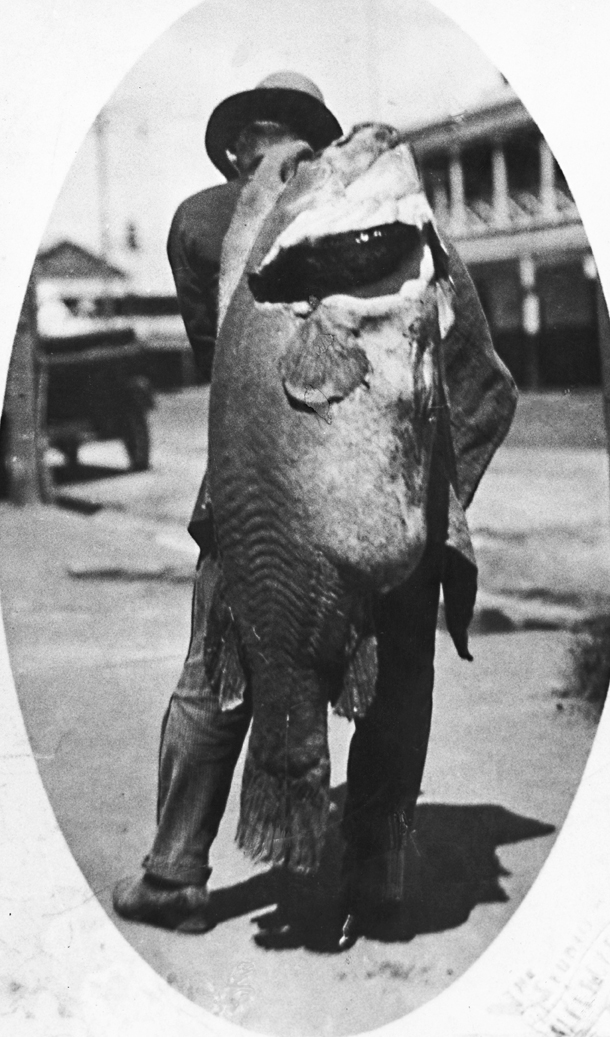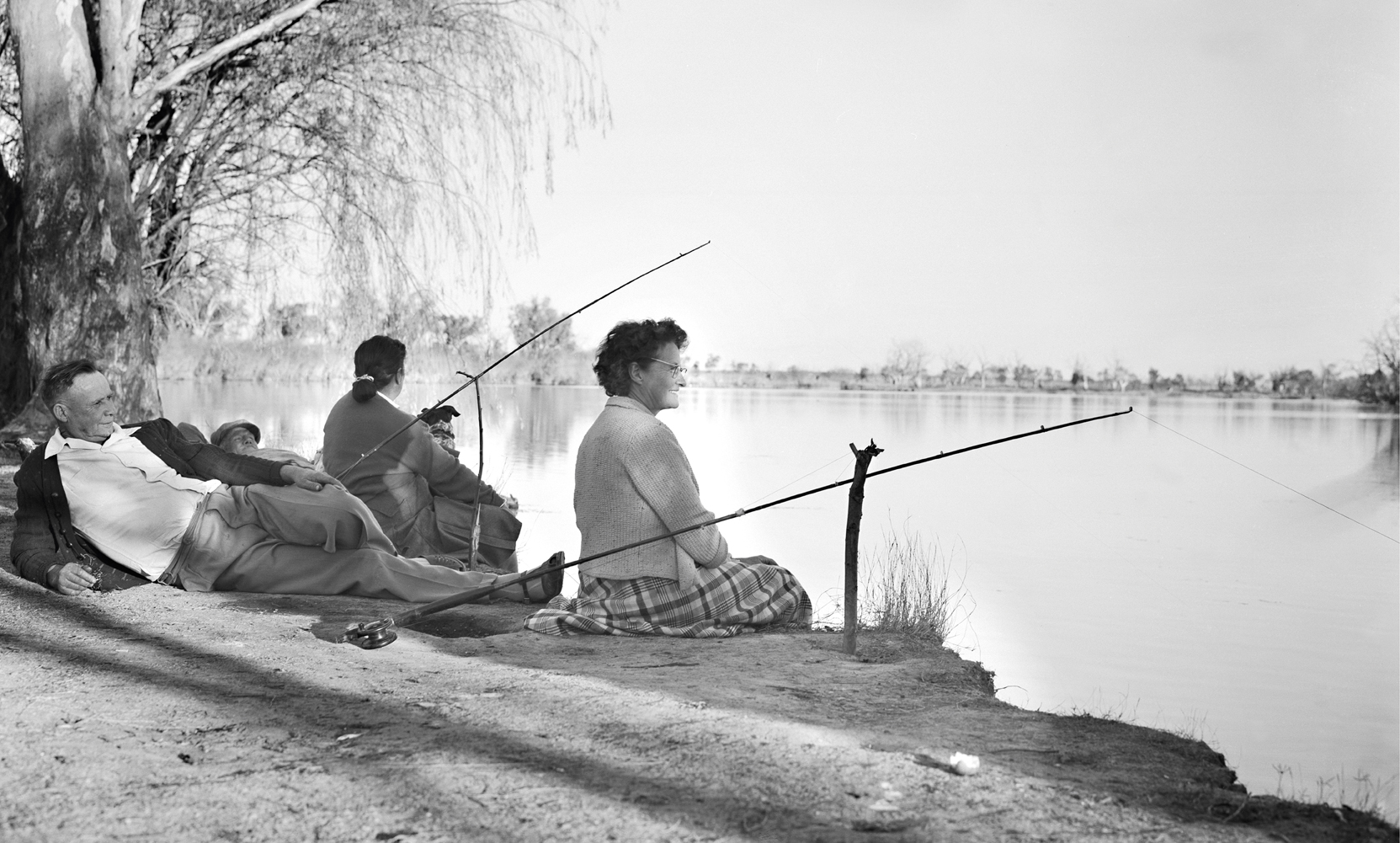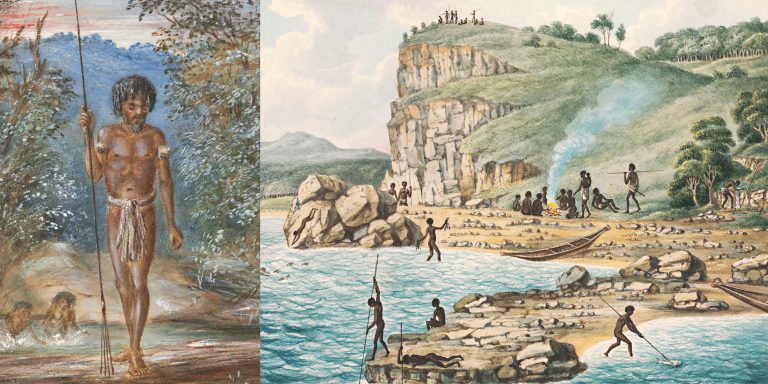WHETHER YOU’RE AN AVID ANGLER OR A ONCE-A-YEAR VISITOR TO THE SEAFOOD MARKETS, THIS BOOK WILL HAVE YOU HOOKED!
JOHN McNAMEE REPORTS
He stands there majestically, by the bush river bank, a study of concentration.
Behind him two women stir up the surface of the water to force the feeding fish to go downstream into shallower pools.
In his hand he holds a long fishing spear which was used with great success and expertise by Aboriginal hunters.
The spear, known among the early colonists as a fish-gig or fizz-gig, was used to probe into the rocky waters to flush out such species as bream or to impale abalone and other shellfish.

The prongs of the spears were hardened and polished and then attached to the long shaft using pieces of thread daubed with resin.
This 1857 painting, called simply Aborigines, is by Thomas Balcombe, and is one of the numerous fascinating illustrations in a new book from the National Library of Australia called The Catch…The Story of Fishing in Australia.
It’s written by Dr Anna Clark, a self-confessed fishing nut, and Australian Research Council Future Fellow and Co-Director of the Australian Centre for Public History at the University of Technology, Sydney.
In the colourful and painstakingly researched book Dr Clark provides a unique insight into the history of fishing, from the first known accounts of indigenous fishing and early European encounters with Australia’s waters, to the latest fishing trends. It also covers the introduction of trout and fly fishing to the challenges of balancing needs of commercial and recreational fishers.
She goes right back in time to provide a detailed and riveting history of indigenous fishing.
“Artefacts such as spears, hooks and nets were some of the many means of indigenous fishing…kangaroo tail tendon was used to bind fish hooks in northern Australia…..nets were made from lengths of finely twisted twine so carefully knotted together that when Arthur Phillip, the first governor of New South Wales, showed them to the white women in the colony, the elegant loops reminded them of English lace…
“To strengthen their fishing powers Aboriginal people sang to their nets; their music and words, literally singing to the fish, were like charms for the Dreaming that cascaded through the weave.”
In her evocative introduction to the book, Dr Clark writes: “When they shut their eyes and pause for a moment, fishers have a place they go to in their mind.
“A special place, a fishing place. Mine is called Paradise, but you won’t find it on any map.
“I can be anywhere, hanging out the washing, sitting in traffic, waiting at the bus stop – and this glorious daydream appears. When the sun catches the side of my face, I close my eyes and I’m there, standing on the water’s edge of Paradise in the late afternoon.
“Every school holidays my family would head out from Sydney to my grandparents’ property on the NSW South Coast. After the long drive we’d spill out of the car and I’d run to look at the tide.
“I still do. If it’s low enough, I grab a nipper pump, a bucket and a rod and run down the dirt track that winds through the bush, across the sandy paddocks and down to the beach……
“Coastal mahogany trees shelter this little spot from the breeze and a bend in the estuary gives a beautiful view across the lake to Mumbulla Mountain….as the sun goes down and the mullet start to jump, everything is covered in a final film of warm, soft light.
“As a kid I used to go down to the beach after dinner and watch ‘the men’ (my grandfather, dad and uncles) spinning off the rocks or bait fishing in the estuary…. they had me casting lures across the paddocks before I was let loose on the rocks…

“Now I go there with my kids and we catch flathead and luderick, trevally and whiting. A mask and snorkel reveal more beauties below the water. Flounder, octopus and leatherjacket hide in the weeds. Rays cover themselves with sand and pretend they’re not there. Sometimes a rogue kingfish or salmon makes it up the estuary and on to the fire, if we’re lucky….
“We like to think of it as our little piece of paradise…but it isn’t of course……there are deep, full middens…shells and bones are scattered through the sandy soil like hundreds and thousands. Countless generations have been here before….”
Dr Clark also chronicles the stormy and often violent relationship between the traditional owners and the settlers as the colony grew and the once rudimentary fishing industry began to develop and plunder the seemingly endless resources of the oceans and waterways.
“Sealers inhabited shacks on remote rocky islands off the south coast and Tasmania and frequently forced indigenous women to live with them in their cold and windy settlements,” she writes.
“There are accounts of Aboriginal pearl divers, in the second half of the 19th century, who were forced to work for nothing, like slaves, diving “naked”— meaning they dived without a snorkel, mask or oxygen—in the deep waters off Shark Bay in Western Australia…..it was dangerous work across the industry: sharks, the ‘bends’ and seasonal cyclones contributed to staggeringly high mortality rates…”
Even from the early days, rock fishing bore an often fatal attraction, as it does today.
“Rock fishing camps were dotted along the coast, with pots and camping gear stuffed behind bushes on cliff tops and among the sand dunes….(some of the more adventurous would be dropped off steamers plying between Melbourne and Sydney) and into the waiting boats of lighthouse keepers from Montague Island who’d take them back to camp and fish on their remote, exposed rocks: It is not a trip for those who are fearsome or sea sick…” one wrote.
There are many wonderful stories of fishing throughout the past two centuries described in the book and Dr Clark’s fascination and love of the subject lift the narrative off the page.
But there are many serious sides to the industry as well .. the development of refrigeration which followed the perilous era of salting fish to preserve them for longer periods and the subsequent outbreaks of poisoning that inevitably followed.
She also chronicles the latest dangers that governments and the industry are being forced to address…overfishing and alarming depletion of stocks of food fish and shellfish.
But is also highlights how technology was one of the game changers for recreational fishing after World War II when in the late 1950s cheap, durable nylon lines became widely available.
Now in every Australian coastal town, there’s a bait shop and a boat ramp and in garages around the country, fishing rods await their next outing and this book illustrates how the sport became popular for both rich and poor.

All of us have a “fishy story” to tell and we could still be avid coastal anglers, keen offshore marlin hunters, once-a-year visitors to the fish markets or just living on the heady memories of when we were kids and dad took us out in leaky boats on the Murray River to catch redfin, or across swirling tidal rock platforms along the Great Ocean Road where we often landed spectacular leatherjackets…
Whatever your feelings about fishing, Dr Clark’s book will transport you along a wonderful historical saga of one of mankind’s oldest and best loved traditions.
The CATCH…The Story of Fishing In Australia. By Dr Anna Clark. NLA Publishing. RRP $39.99
Main Pictures:
Left: This Thomas Balcombe painting of 1857 shows an Aboriginal fisherman plying a long-shafted spear along a bush river. Two women splash in the shallows behind him to attract fish.
Right: A community of Aboriginal fishers, spotting from cliff tops, pulling crays out of the rocks, spearing and cooking the catch. Painting by Joseph Lycett (circa 1817)




